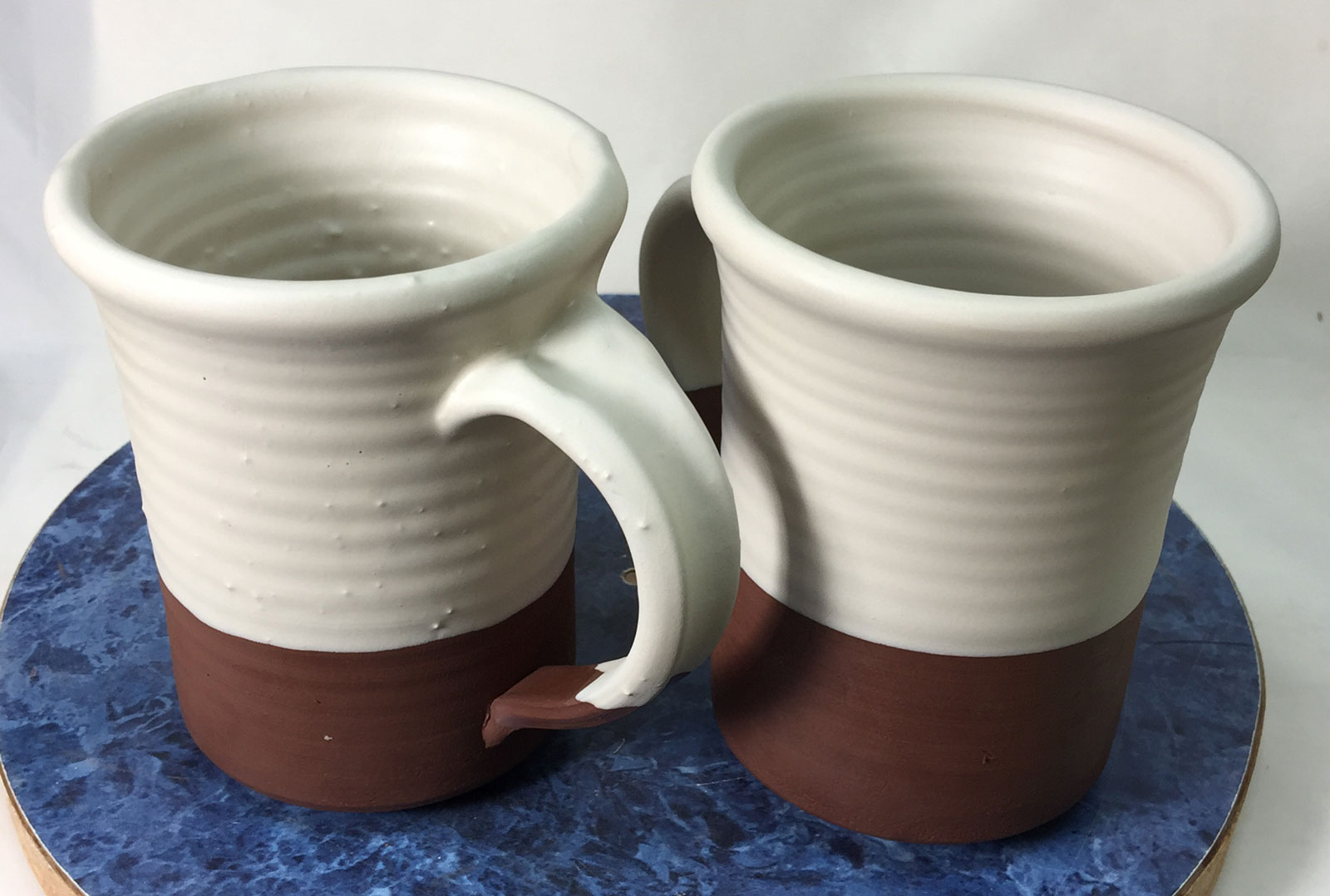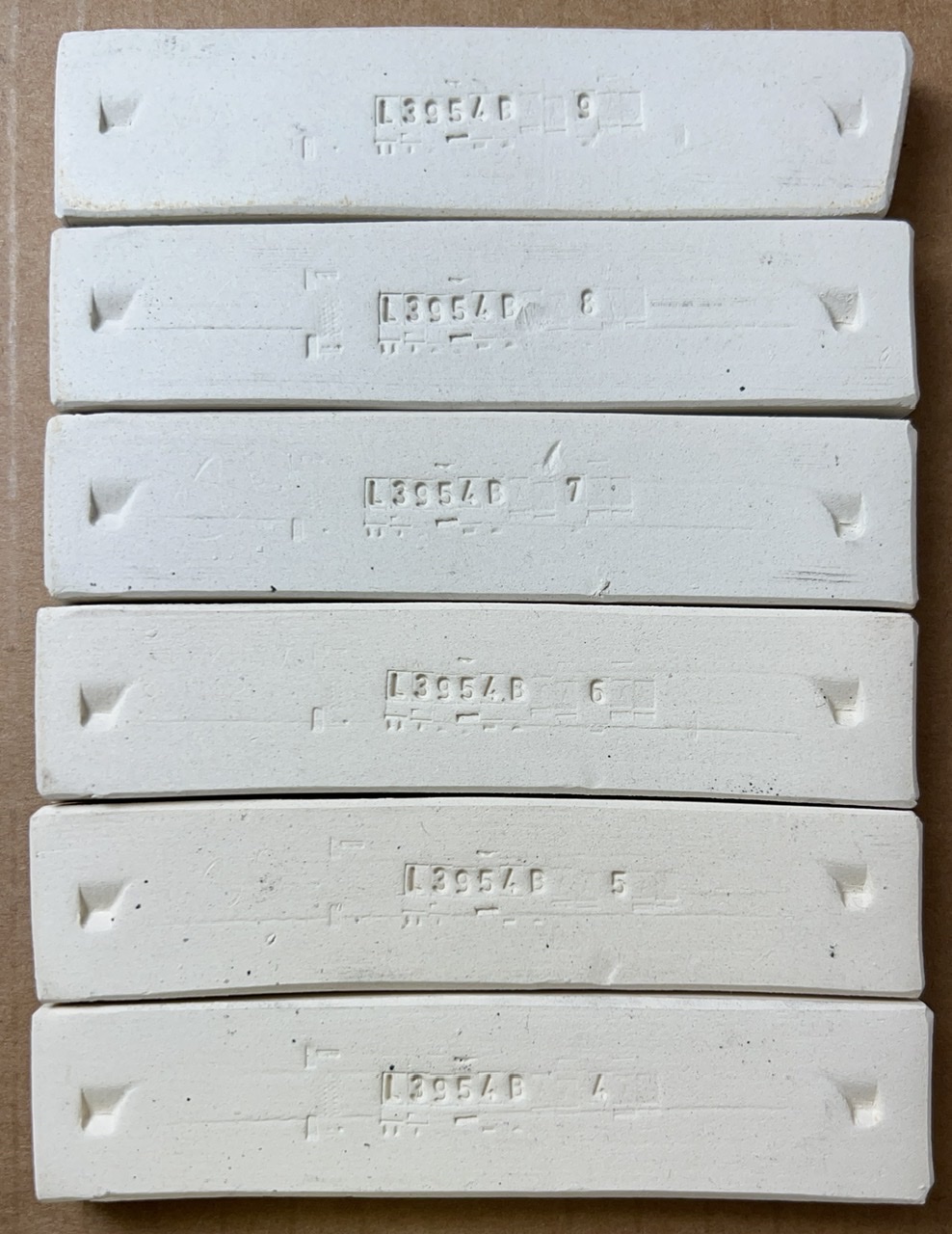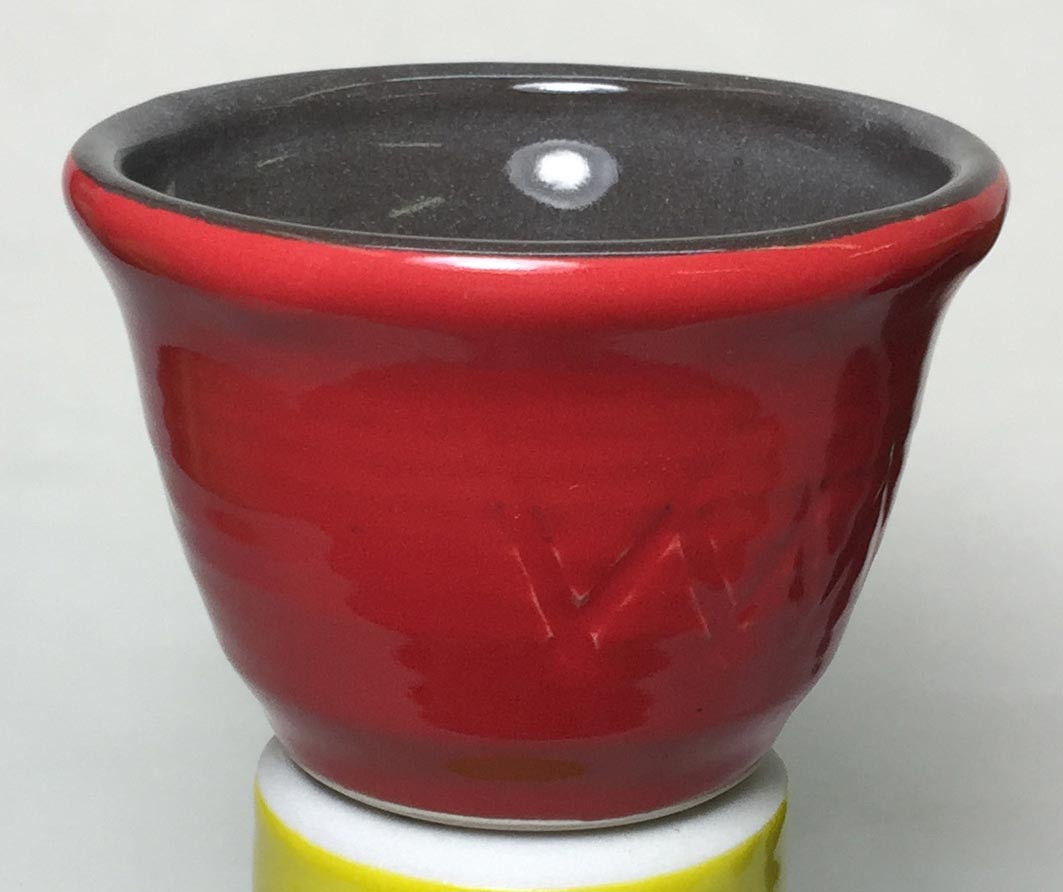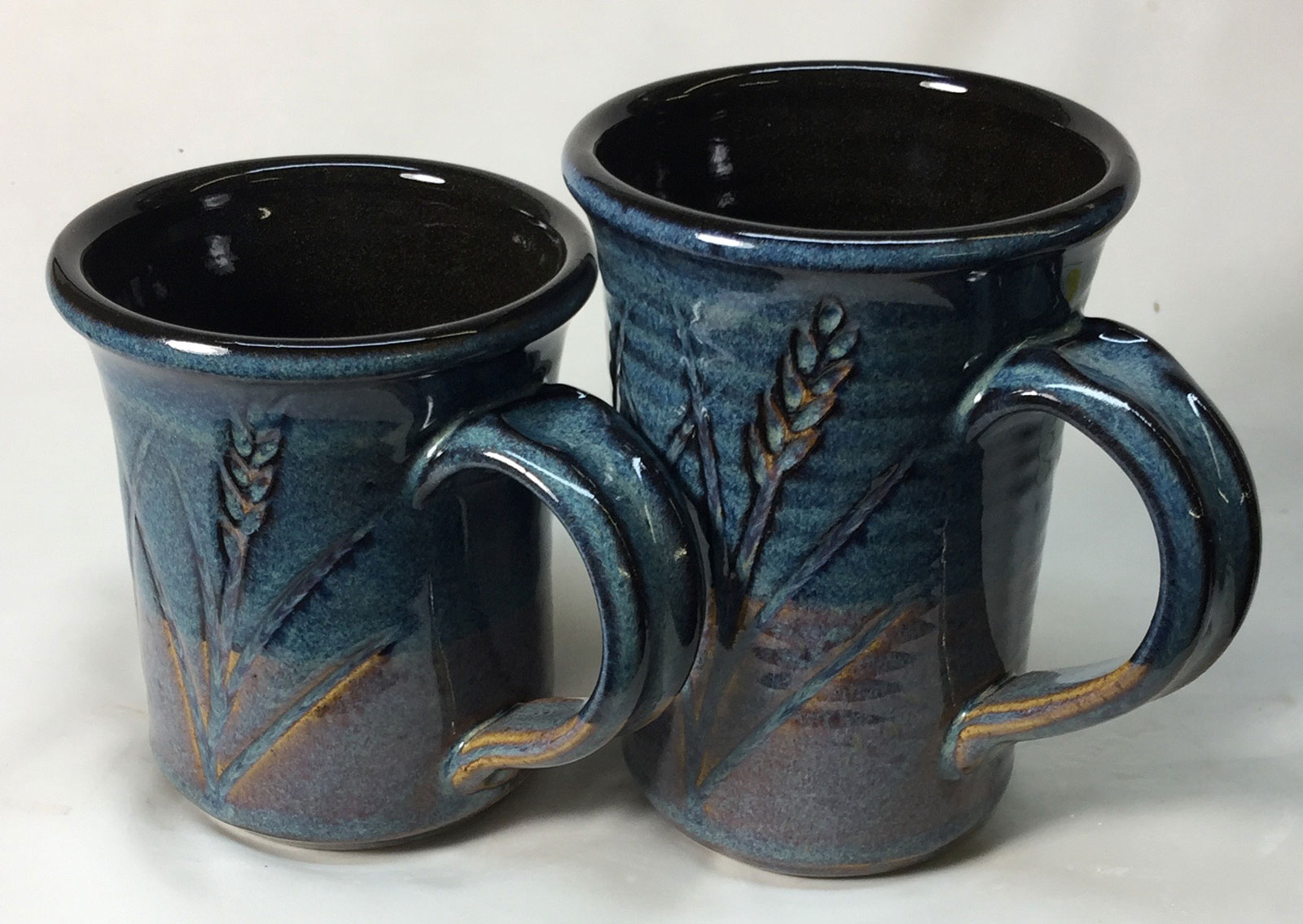Project Name
Cone 6 Engobe
Project Codenumber
UnAssigned
Notes
Engobes, used in pottery, are not slips (which are normally applied by brushing). Engobes are applied thickly (usually by dipping or pouring) and achieve total opacity. It is vital the slurry has the right rheology to work properly. Follow the links on this page and read carefully, it will mean the difference between success and failure.
Ball Clay: We substitute Old Hickory M23, OM#4 and Gleason (as available). Use whatever ball clay you have, most are very similar.
Nepheline Syenite: To increase and reduce the fired shrinkage we add and remove this. Feldspars are not as white and don't flux as well.
Silica: Normally, 25% silica is needed in porcelains to assure fit with common glazes. But B and F contain plenty of ball clay and that supplies significant quartz.
Bentonite: Present to make it sticky, gel better and increase plastic strength. Many engobes have more bentonite than this (e.g. 5-10%). However, with this much ball clay about 3% bentonite is sufficient to produce the needed drying shrinkage to match the target clay bodies.
This is applied at stiff leather-hard stage (it will flake off if applied to dry or bisque). On application, it will rewet leather-hard pieces and they will require significant time to re-stiffen to the same state. Even coverage can normally only be achieved by preparing a slurry of the correct rheological properties and dipping or pouring.
It is vital that you have a good mixer. To mix this use the process described on the Engobe glossary page at the Digitalfire Reference Library.
Super-White Version: This, the third column, is still in development.
Cone 6 White Engobe Recipe
Drying and firing shrinkage fitted to Plainsman M390, M340
|
Code # L3954B |
Batch # 3 |
| Materials | Amt |
|---|---|
| Nepheline Syenite | 18.000 |
| Silica | 15.000 |
| OM #4 Ball Clay | 54.000 |
| Additions | |
|---|---|
| Zircopax | 10.000 |
| Bentonite | 3.000 |
Total:100.00
|
Si:Al: 5.6:1 5.9 (Molar:5.5) 6.3 |
Notes
This is white because of the 10% Zircopax. Increase that 20% for maximum white. The black version of this is L3954F.
This recipe has been tuned to have about the same fired shrinkage as Plainsman M390, Coffee Clay and M340 at cone 6 (we measure this at 6.7% dry-to-fired shrinkage using the SHAB test). We also confirmed fired-shrinkage-match using the EBCT test). If the body you use has between 6.5 and 7.0 fired shrinkage, this should work. Do not ignore this detail. If you apply this as an engobe (e.g. by dipping leather-hard functional pieces), and it is not firing-shrinkage-compatible with the body, it could eventually flake off during use.
The color is whiter than previous trials (because of the zircopax), but some might prefer a little blue stain to brighten the color. We used 0.2% Mason 6336 with good success, other stains we tried agglomerated and caused specking). For a super white see the L3954R recipe.
As will other engobes we recommend mixing in a kitchen blender, it is an ideal way to get the lumps out and thoroughly wet all particle surfaces.
A thixotropic dipping slurry is needed and we have found it is possible to create a deflocculated one using 1000 powder, 780g water, ~3g Darvan. This produces a specific gravity of ~1.55. If it is too viscous add more Darvan, too fluid add a tiny amount of Epsom salts to bring it back to a creamy texture.
A brushing version can also be made, see the notes for the L3954F black engobe.
Pictures
L3954B Very sensitive to over deflocculation

Only 3 drops of darvan in 3/4 gallons of slip fixed the problem on the left. The slurry was over flocculated using Epsom Salts.
M390:3954B engobe BiClay strips after drying

These were laminated in plastic form. Two were dried red body side up, two with the engobe side up. Results are very flat, very good drying shrinkage fit.
L3954B engobe:red stoneware biclay cones

The white engobe was prepared in plastic form and rolled and laminated with the red body. The thin strips were dried and fired to cone 6 to find incompatibilities in drying and firing shrinkage.
Results are very good, slight curling toward M390 (the Plainsman red burning body) on drying, a little more toward the white slip on firing.
10% black and red stains in L3954B Engobe

Black is Mason 6666. Although color is good, Mason 6600 is the recommend one for bodies.
Red is Mason 6021. Much more will be required to get good color.
L3954B with Burnt Umber and Black Stain

Both replace the 10% zircopax with a black pigment. They darken the engobe to near black. But the stain version (Mason 6600) on the right fires blacker and develops the color of this rutile glaze (Alberta Slip rutile blue) much better. It also produces a perfect glass surface whereas the Umber version on the left develops some pinholing in the inside glaze (GA6A Alberta Slip base).
L3954B White/Black BiClay bars

There was a slight bend toward the black on drying on one, the other was straight. There was no change on firing.
Untitled

L3954B Cone 6 Black Engobe fired bars

URLs
PlainsmanClays mix..nstructions L3954B
L3954B pictures an..italfire Reference
Information about .. Reference Library
Testdata
SHAB - Shrinkage/Absorption
| DLEN | FLEN | FWT | BWT | CONE | DSHR | FSHR | ABS | |
| 9 | 92.74 | 84.46 | 39.88 | 39.9 | 9.0 | 7.3% | 8.9% | 0.1% |
| 8 | 92.43 | 84.4 | 38.85 | 38.97 | 8.0 | 7.6% | 8.7% | 0.3% |
| 7 | 92.23 | 84.53 | 38.77 | 39.21 | 7.0 | 7.8% | 8.3% | 1.1% |
| 6 | 92.49 | 85.3 | 40.20 | 41.1 | 6.0 | 7.5% | 7.8% | 2.2% |
| 5 | 92.65 | 86.33 | 40.33 | 41.85 | 5.0 | 7.3% | 6.8% | 3.8% |
| 4 | 92.84 | 87.18 | 41.81 | 44.11 | 4.0 | 7.2% | 6.1% | 5.5% |
| 3 | 92.95 | 87.62 | 40.89 | 43.65 | 3.0 | 7.1% | 5.7% | 6.7% |
| 2 | 93.06 | 88.17 | 41.26 | 44.46 | 2.0 | 6.9% | 5.3% | 7.8% |
EBCT - Engobe Body Compatibility Test
| MATA | MATB | BNDR | BNFR | BCON | |
| 1 | M390 | L3954B | 1.5mm/A | 3.0mm/B | 6.0 |
XML (to paste into Insight)
<?xml version="1.0"?> <recipes version="1.0" encoding="UTF-8"> <recipe name="Cone 6 White Engobe Recipe" keywords="Drying and firing shrinkage fitted to Plainsman M390, M340" id="113405" key="qGefixgz" date="2023-10-23" codenum="L3954B"> <recipelines> <recipeline material="Nepheline Syenite" amount="18.000" tolerance=""/> <recipeline material="Silica" amount="15.000" tolerance=""/> <recipeline material="OM #4 Ball Clay" amount="54.000" tolerance=""/> <recipeline material="Zircopax" amount="10.000" added="true"/> <recipeline material="Bentonite" amount="3.000" added="true"/> </recipelines> </recipe> </recipes>
Born: 2016-12-12, Modified: 2023-10-23 18:06:17
Cone 6 Black Engobe
|
Code # L3954F |
Batch # 3 |
| Materials | Amt |
|---|---|
| Nepheline Syenite | 18.000 |
| Silica | 15.000 |
| M23 Ball Clay | 54.000 |
| Additions | |
|---|---|
| Bentonite | 3.000 |
| Mason 6600 Stain | 15.000 |
Total:105.00
Notes
This is the black version of L3954B White. Reduce the percentage of stain for less intense black.
Fires jet-black, much blacker than any black burning clay body on the market. Because particulate stain particles supply the color this is not messy to work with, just water will completely clean any surface (unlike black bodies made using raw or burnt umber). This will remove from clean plaster batt without leaving any stain.
We make a brushing version of this by mixing a 500 gram batch with 75g of Laguna Gum Solution and 280g water (fits 1 pint jar). It must be mixed in a kitchen blender to get the lumps out. It dries without cracking when painted onto an arborite surface and requires a metal scraper to get it off.
Pictures
10% 6666 stain in engobe under a clear glaze

10% 6600 stain bowl

Lots of bubbles. But clay is very black.
L3954B with Burnt Umber and Black Stain

Both replace the 10% zircopax with a black pigment. They darken the engobe to near black. But the stain version (Mason 6600) on the right fires blacker and develops the color of this rutile glaze (Alberta Slip rutile blue) much better. It also produces a perfect glass surface whereas the Umber version on the left develops some pinholing in the inside glaze (GA6A Alberta Slip base).
Black stain L3954F vs. Raw Umber black clay

L3954F black egobe with 7.5% stain

The center bar has 7.5% Mason 6600.
The bottom one has 15%.
The top one is a body havig 10% raw umber.
L3954F black cone 6 engobe fired bars

M340 mugs with L3954F black engobe, Ravenscrag blue

URLs
Testdata
SHAB - Shrinkage/Absorption
| DLEN | FLEN | FWT | BWT | CONE | DSHR | FSHR | ABS | |
| 5 | 92.96 | 86.72 | 39.66 | 39.69 | 6.8 | 7.0% | 6.7% | 0.1% |
| 6 | 92.99 | 86.08 | 40.74 | 40.75 | 6.2 | 7.0% | 7.4% | 0.0% |
XML (to paste into Insight)
<?xml version="1.0"?> <recipes version="1.0" encoding="UTF-8"> <recipe name="Cone 6 Black Engobe" id="115180" key="Tgmytno4" date="2023-05-28" codenum="L3954F"> <recipelines> <recipeline material="Nepheline Syenite" amount="18.000" tolerance=""/> <recipeline material="Silica" amount="15.000" tolerance=""/> <recipeline material="M23 Ball Clay" amount="54.000" tolerance=""/> <recipeline material="Bentonite" amount="3.000" added="true"/> <recipeline material="Mason 6600 Stain" amount="15.000" added="true"/> </recipelines> </recipe> </recipes>
Born: 2016-12-12, Modified: 2023-05-28 23:03:28
Super-White Engobe for Cone 6
|
Code # L3954R |
| Materials | Amt |
|---|---|
| Nepheline Syenite | 15.000 |
| New Zealand Kaolin | 60.000 |
| Silica | 25.000 |
| Additions | |
|---|---|
| Veegum T | 3.000 |
| Zircopax | 20.000 |
Total:123.00
Notes
Like L3954B, this is targeted at cone 6 stonewares. To achieve the extra whiteness, several measures are being explored here:
-No ball clay, only the whitest kaolin available is being used.
-Bentonite is being substituted for VeeGum.
-Zircopax has been doubled.
-Silica has been increased (since the kaolin does not supply it as the ball clay did).
-Less Nepheline is needed because the VeeGum is a super-flux.
Mixed 1000 dry, 1000 water, 6 Darvan. Applied really well.
This has a firing shrinkage that is much too high. Subsequent tests are underway and will be posted here during Feb 2022. They add 10 wollastonite at the expense of kaolion and nepheline, this dramatically reduces firing shrinkage.
Pictures
L3954R on P6954

The initial mix, was too viscous so I was able to apply it quite thick (and it stays in place).
With P6954 after drying (front) and after cone 6 (back)

As this EBCT test shows, it needs more bentonite to increase drying shrinkage and less feldspar to reduce firing shrinkage.
It measured 6 mm toward the stoneware after drying but 18mm toward the engobe after firing.
On P6954, this was just applied at leather hard stage

Very good application, gelled perfectly.
L3954R at cone 5 and bisque fired

The body is M340. After bisque fire the engobe appears to over and fit well. But at cone 6 it is clear it is fire-shrinking too much (see cracks at bottom of recesses). The top bar is Polar Ice, the whitest porcelain we can make (yet this engobe is much whiter!)
XML (to paste into Insight)
<?xml version="1.0"?> <recipes version="1.0" encoding="UTF-8"> <recipe name="Super-White Engobe for Cone 6" id="211995" key="Dft784ba" date="2022-02-22" codenum="L3954R"> <recipelines> <recipeline material="Nepheline Syenite" amount="15.000" tolerance=""/> <recipeline material="New Zealand Kaolin" amount="60.000" tolerance=""/> <recipeline material="Silica" amount="25.000" tolerance=""/> <recipeline material="Veegum T" amount="3.000" added="true"/> <recipeline material="Zircopax" amount="20.000" added="true"/> </recipelines> </recipe> </recipes>
Born: 2021-03-08, Modified: 2022-02-22 16:40:39
White Engobe for M340, M390, L215, L210
|
Code # L3954S2 |
| Materials | Amt |
|---|---|
| Nepheline Syenite | 10.000 |
| New Zealand Kaolin | 55.000 |
| Silica | 25.000 |
| Wollastonite | 10.000 |
| Additions | |
|---|---|
| Veegum T | 3.000 |
| Zircopax | 20.000 |
Total:123.00
Notes
This recipe alters L3954R by switching 5 kaolin and 5 Nepheline for 10 wollastonite. This change significantly reduces the firing shrinkage, matching that of M340 at cone 6 and of L215 at cone 04. It is easy to make, equal parts water (and Darvan to achieve the best viscosity).
Use the highest speed of your mixer. More Darvan may be needed later also.
Blend this with L3954R to increase the firing shrinkage if needed to match more vitreous bodies (the effect will be less wollastonite, more kaolin).
Pictures
Testdata
SHAB - Shrinkage/Absorption
| DLEN | FLEN | FWT | BWT | CONE | DSHR | FSHR | ABS | |
| 2 | 93.82 | 85.62 | 32.36 | 33.99 | 8.0 | 6.2% | 8.7% | 5.0% |
| 7 | 93.82 | 87.2 | 33.54 | 36.64 | 7.0 | 6.2% | 7.1% | 9.2% |
| 6 | 93.62 | 87.5 | 33.53 | 37.17 | 6.0 | 6.4% | 6.5% | 10.9% |
| 4 | 93.47 | 87.4 | 33.51 | 37.57 | 5.0 | 6.5% | 6.5% | 12.1% |
| 5 | 93.4 | 87.7 | 33.74 | 37.82 | 5.0 | 6.6% | 6.1% | 12.1% |
| 3 | 93.55 | 88.25 | 33.12 | 37.82 | 3.0 | 6.5% | 5.7% | 14.2% |
| 8 | 93.8 | 89.17 | 32.89 | 32.89 | -2.0 | 6.2% | 4.9% | 0.0% |
| 1 | 94.05 | 89.88 | 32.09 | 37.44 | -4.0 | 6.0% | 4.4% | 16.7% |
XML (to paste into Insight)
<?xml version="1.0"?> <recipes version="1.0" encoding="UTF-8"> <recipe name="White Engobe for M340, M390, L215, L210" id="212872" key="hbeMmPTD" date="2025-09-26" codenum="L3954S2"> <recipelines> <recipeline material="Nepheline Syenite" amount="10.000" tolerance=""/> <recipeline material="New Zealand Kaolin" amount="55.000" tolerance=""/> <recipeline material="Silica" amount="25.000" tolerance=""/> <recipeline material="Wollastonite" amount="10.000" tolerance=""/> <recipeline material="Veegum T" amount="3.000" added="true"/> <recipeline material="Zircopax" amount="20.000" added="true"/> </recipelines> </recipe> </recipes>
Born: 2021-03-08, Modified: 2025-09-26 20:35:28
